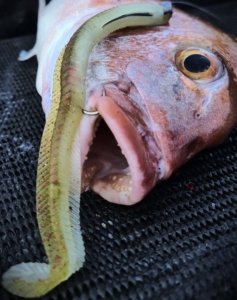Brisk winter fishing trips chasing snapper are ON! …when the wind allows, but they’re needing a bit more planning to come home with fresh fish, and not

Catch Eels catching snapper, low ‘n slow motion is the go for prime winter fish.
having to grab some sausages for the BBQ on the way home from the ramp. Here’s a typical day over the past few winter sessions, the indicators and fishing influences prior to launch and what actually happened, interesting stuff, mostly fact, some more opinion and experience, with several of the main factors checked and planned around typically before heading out.
Wind direction and speed to determine the actual sea surface: Metvuw.com has one of the most accurate weather forecasts around, easy to read isobars and a great overall view with a basic understanding of weather data. Windy.com is excellent for both wind speed (average and gust strength) and most importantly for the Hauraki Gulf, the areas of calm wind, often one side or even smallish areas can be beautifully calm, another windy choppy and unpleasant, just a short distance away. Swellmap.co.nz graphs showing tide changes (match up directions with Windy) and tidal strength are a real key for surface conditions, stronger tide means wind opposing tide will stand the waves up much more. Also check the swell height and interval – a 1m swell may not be noticed at 15 seconds apart, but at 5 seconds can mean very lumpy and a potentially seasick crew. So, when the factors all roughly align (or not!) a very accurate prediction of fishing conditions and how they will change throughout the day can be made.
Winter means a lot of hibernation time for snapper (and humans), so checking bite times (moon phase) can help, the previous week the full moon with a slight southerly wind would typically mean a much shorter bite, mid tide is usually best for bite with current flow and activity – so a midday high tide indicated a mid-morning bite which may only last 15 to 30 minutes. It pays to have your gear prepped and ready to go, no time to be tying a PR knot once you’re out there, over fish, with wet cold hands and a rocking boat, tick tock.
Even with a few dolphins milling around, a whale off in the distance cruising through the snapper bite could have been timed on a watch, short sharp aggressive feeding, short lived, then back to ‘Where’s The Fish’? Feeding over and back to very tentative barely detectable bites – best to try microjigs or very slow moving kabura to keep catching snapper, albeit at a much slower rate, until midafternoon/mid tide again in the afternoon. You could have set your watch to the mid tide bite start and stop. Of course, this is nature and there are many more factors that can improve or worsen the bite.
And so it was – short sharp bite times, good snapper feeding mid tide but a lot less otherwise. Interestingly the success of kayakers in and around mussel farms has been standout in effectiveness, those little softbaits and microjigs cast generally from outside towards the mussels, extending the short bite with good numbers of snapper in the area welcomed aboard. Just like land-based bait anglers who do well over winter using smaller, mere bite-sized baits, using lures jigs and softbaits it’s a great idea to start with small lolly-like temptations rather than present a ‘big Kahuna burger’ meal.
A delicious looking Eel like the one pictured swimming slowly along, grubbing the sea floor puffing up a bit of telltale mud giving away its position is a perfect softbait presentation for several snapper to snaffle, fresh fish on the winter BBQ!
Bottom end Waiheke, 40m off the top of Waiheke, just out from the Tiri channel, mid-ground of the gulf with a couple of whales, and even some action in the Tamaki Strait this week – action stations are moving around a lot, but action there is to be found.
The daylight hours are lengthening with only 2 weeks to Spring, it’s time to really gear yourself up and make this summer of fishing one to truly remember, good times, friends, family and great fishing.
Cheers






